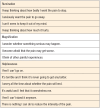High Pain Catastrophizing Scale Predicts Lower Patient-Reported Outcome Measures in the Foot and Ankle Patient
- PMID: 35607813
- PMCID: PMC11667948
- DOI: 10.1177/19386400221093865
High Pain Catastrophizing Scale Predicts Lower Patient-Reported Outcome Measures in the Foot and Ankle Patient
Abstract
Background: Postoperative outcomes may be affected by the patient's preoperative morbidity. It is hypothesized that patient's pain catastrophization prior to foot and ankle surgery may affect their patient-reported outcomes. Methods: This study prospectively assessed a consecutive cohort of 46 patients undergoing foot and ankle reconstruction to describe the relationship between Pain Catastrophizing Scale (PCS) and patient-reported outcomes measured by 12-item Short Form Health Survey and Foot and Ankle Outcome Score (FAOS).
Results: The 1-year postoperative FAOS pain, activities of daily living, and quality of life scores correlated significantly with all baseline PCS subcategories. We found that the mental domain of the SF-12 had a statistically significant correlation with the rumination and helplessness PCS subcategories.
Conclusion: This study showed a significant association between a high preoperative PCS and a worse 1-year FAOS. As such, catastrophization could be screened for and potentially treated preoperatively to improve patient-reported outcomes in elective foot and ankle surgery.
Level of evidence: Therapeutic, Level III Evidence.
Keywords: ankle; catastrophization; disability; foot; function; pain.
Conflict of interest statement
Declaration of Conflicting InterestsThe author(s) declared no potential conflicts of interest with respect to the research, authorship, and/or publication of this article.
Figures
Similar articles
-
Pain Catastrophizing Scale Associated With Other Patient-Reported Outcome Measures in Plantar Fasciitis and Chronic Ankle Instability Patients.Foot Ankle Int. 2022 Oct;43(10):1340-1345. doi: 10.1177/10711007221106472. Epub 2022 Jul 6. Foot Ankle Int. 2022. PMID: 35794824
-
Validation of Patient-Reported Outcomes Measurement Information System Computerized Adaptive Tests Against the Foot and Ankle Outcome Score for 6 Common Foot and Ankle Pathologies.Foot Ankle Int. 2017 Aug;38(8):870-878. doi: 10.1177/1071100717709573. Epub 2017 Jun 10. Foot Ankle Int. 2017. PMID: 28602138
-
Resilience and pain catastrophizing among patients with total knee arthroplasty: a cohort study to examine psychological constructs as predictors of post-operative outcomes.Health Qual Life Outcomes. 2021 May 1;19(1):136. doi: 10.1186/s12955-021-01772-2. Health Qual Life Outcomes. 2021. PMID: 33933091 Free PMC article.
-
Patient Factors Associated With Higher Expectations From Foot and Ankle Surgery.Foot Ankle Int. 2017 May;38(5):472-478. doi: 10.1177/1071100717690807. Epub 2017 Feb 14. Foot Ankle Int. 2017. PMID: 28196438
-
Outcome measures after foot and ankle surgery: A Systematic Review.Foot Ankle Surg. 2025 Feb 22:S1268-7731(25)00036-0. doi: 10.1016/j.fas.2025.02.005. Online ahead of print. Foot Ankle Surg. 2025. PMID: 40021414 Review.
Cited by
-
A prospective study of the association between pain and catastrophizing after selective nerve root blockade.Pain Pract. 2025 Mar;25(3):e70017. doi: 10.1111/papr.70017. Pain Pract. 2025. PMID: 40035355 Free PMC article.
References
-
- Ware J, Jr., Kosinski M, Keller SD. A 12-Item Short-Form Health Survey: construction of scales and preliminary tests of reliability and validity. Med Care. 1996;34(3):220-233. - PubMed
MeSH terms
LinkOut - more resources
Full Text Sources
Research Materials


